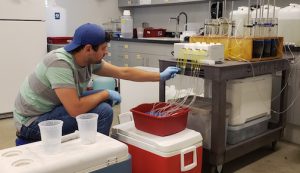You have likely noticed the ponds and small lakes in your community that are often paired with a newer residential or commercial development. Maybe you fished in them, canoed across them, or go to them to spot wildlife attracted to the water. Stormwater ponds are a crucial part of your community’s stormwater management infrastructure. They are designed and built to reduce flooding risks in developed landscapes. Stormwater ponds can either be ‘wet ponds’ that permanently have water and are intended for flood protection or ‘dry ponds’ that temporarily hold water and are primarily intended for water quality protection.
Although flood protection is the primary purpose, wet stormwater ponds are also beneficial for the environment. They provide habitat for plants and animals, but they also remove excess nutrients (like nitrogen and phosphorus) and other pollutants (like sediment) from urban runoff before it is discharged to natural waterways. City managers are especially interested in nitrogen because that can be permanently removed by microorganisms living in the sediment and water. Stormwater ponds represent a buffer between developed landscapes and natural ecosystems and are expected to play a pivotal role in helping to improve water quality and mitigate unhealthy and unsightly algal blooms.

(Photo by Asher Williams)
Since January 2019, we have been working on a project to better understand nutrient dynamics in storm-water ponds. In order to do this, we collect sediment cores from stormwater ponds throughout Miami-Dade County and the City of Gainesville. These ponds range in age from ten to 30 years old. We bring the sediment back to the lab for analysis. We measure nutrient concentrations in the water and how it is affected by sediment from different ponds. Ultimately, we will use these results to estimate how much nitrogen and phosphorus each pond removes.
Preliminary results from January suggest these ponds have the potential to remove nitrogen from runoff, particularly when nitrogen concentrations are high. In our study, older ponds removed more nitrogen than younger ponds, suggesting that pond age may play a role in the ability to remove nutrients from runoff. We are currently analyzing samples from June to compare seasonal differences in nutrient dynamics, and we hope to identify specific factors about the ponds that control nutrient removal. If we can identify these factors, we can develop recommendations for better ways to design and manage stormwater ponds to maximize nutrient removal. For example, if ponds with more organic matter in the sediments have higher nutrient removal rates, it would suggest that pond management should prioritize practices that increase organic matter in the system.
Florida’s population continues to grow. As new neighborhoods are built across the state, infrastructure is needed to minimize impacts on flooding and water quality. Ponds are the most common infrastructure used for stormwater management. It is increasingly important to better understand the drivers of nutrient removal in these ponds to protect the water quality, habitat, aesthetics, and recreational opportunities of our natural waterways. Overall, this research will help provide scientists, managers, and engineers a better mechanistic understanding of nutrient availability within storm-water ponds. That should lead to the development of targeted management actions for enhanced nutrient removal.
This article first appeared in the Miami-Dade Extension Connection Summer 2019 issue. It is published here with permission from UF/IFAS Extension Miami-Dade County.
Written by Steven P. Hohman, Master’s student, UF/IFAS Soil and Water Sciences Department, Ashley R. Smyth, assistant professor, UF/IFAS Soil and Water Sciences Department, Tropical Research and Education Center, and Alexander J. Reisinger, assistant professor, UF/IFAS Soil and Water Sciences Department
 0
0
